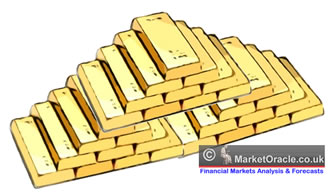Gold Breakout Targets $1,325 on Flood of Liquidity
Commodities / Gold & Silver 2009 Sep 08, 2009 - 06:09 AM GMTBy: Adrian_Ash
 THE PRICE OF GOLD rose to an 18-month high for US investors in early London trade on Tuesday, breaking Feb's high of $1,006 an ounce as world stock markets rose for the third session running and crude oil gained 2.5%.
THE PRICE OF GOLD rose to an 18-month high for US investors in early London trade on Tuesday, breaking Feb's high of $1,006 an ounce as world stock markets rose for the third session running and crude oil gained 2.5%.
Ahead of New York traders returning from the long Labor Day weekend, the Dollar fell hard on the foreign exchange market, dropping to a two-week low of $1.6550 per Pound and a new 2009 low of $1.4480 against the Euro.
UK investors looking to Buy Gold saw the price hit its best level since May 18th at £613 an ounce.

The Gold Price in Euros touched last week's 5-month high at €699.
"Gold has started September in bullish mood, due – it appears – to a surge in investment demand," reports the new Precious Metals Monthly from Darran Grabham at Standard Bank in Johannesburg.
"Last week’s strong rally has produced a break out of the short-term triangular consolidation pattern. We [now] forecast a move well beyond last year’s $1,030.80 high. The minimum objective of the triangle breakout is situated at $1,100 with an extended target of $1,180.
"Within the long-term trend," says Standard Bank, "this has greater bullish implications...with a target of $1,325."
On the economic front Tuesday, the UK reported better-than-expected Industrial Output growth for July, but Germany showed a near-1% drop month-on-month.
Japan's Eco-Watchers Survey of analyst sentiment fell to a four-month low. Swiss unemployment rose less quickly than analyst forecasts.
"Gold's rising price is due to uncertainty," said analyst Sandra Close at Australia's Surbiton Associates to Reuters overnight.
"There are questions out there over the health of economies, where interest rates are going. All that encourages gold hoarding. There's potential to see the price go even higher."
"The gold market felt very firm as London traders entered," says one UK dealer in a note.
But "We are unconvinced that all the ingredients are in place for a sustained surge higher in gold," says John Reade, head of precious metals analysis for Swiss banking giant UBS in London.
The most typical autumn pattern for Gold Prices – rising above the spring's high after a summer dip in 20 of the last 39 years – has delivered 10% gains on average over the six months to Feb.
However, Indian jewelry demand amid the post-harvest festival season is expected to be weak in 2009. Consumers face record-high Rupee prices, a slowdown in the economy, and a smaller-than-average harvest.
"Gold is going higher primarily because the supply of paper with ink on it is seemingly inexhaustible but precious metals supply is relatively constant," says Gene Arensberg in this week's Got Gold Report.
"The fact gold is rising reflects growing contempt of government's inability to stay within its means."
Here in the UK – where the Bank of England's quantitative easing has now bought government bonds equal to the Treasury's record deficit for 2009-to-date – the volume of notes and coin in circulation rose 8.9% in August from the same month last year.
Annualized growth in narrow money averaged across the last 6 months reached its fastest rate of growth since the Millennium Bug scare of 1999-2000, a level previously seen at the tail-end of the 1970s' inflation.
At last weekend's political meeting in London, "The G-20 countries said they would continue to flood the system with liquidity so the economy doesn't tank," noted Francis Lun at Fulbright Securities in Hong Kong to the AP newswire this morning.
"That's what [stock-market] investors wanted to hear. Investors always want to believe the good news and disregard the bad."
Pointing at the US Federal Reserve's sole management of the world's No.1 reserve currency, the US Dollar, "Greater international stability requires an overhaul of the entire monetary and financial system," says a report from the United Nations' Conference on Trade & Development issued on Monday.
"Countries should adopt a system of managed flexible exchange rates," it says, calling for a return to the post-WWII Bretton Woods system – minus the gold-backing given to US Dollars until 1971. "The IMF [should also] be pressing surplus countries to carry out more expansionary policies."
By Adrian Ash
BullionVault.com
Gold price chart, no delay | Free Report: 5 Myths of the Gold Market
City correspondent for The Daily Reckoning in London and a regular contributor to MoneyWeek magazine, Adrian Ash is the editor of Gold News and head of research at www.BullionVault.com , giving you direct access to investment gold, vaulted in Zurich , on $3 spreads and 0.8% dealing fees.
(c) BullionVault 2009
Please Note: This article is to inform your thinking, not lead it. Only you can decide the best place for your money, and any decision you make will put your money at risk. Information or data included here may have already been overtaken by events – and must be verified elsewhere – should you choose to act on it.
Adrian Ash Archive |
© 2005-2022 http://www.MarketOracle.co.uk - The Market Oracle is a FREE Daily Financial Markets Analysis & Forecasting online publication.



